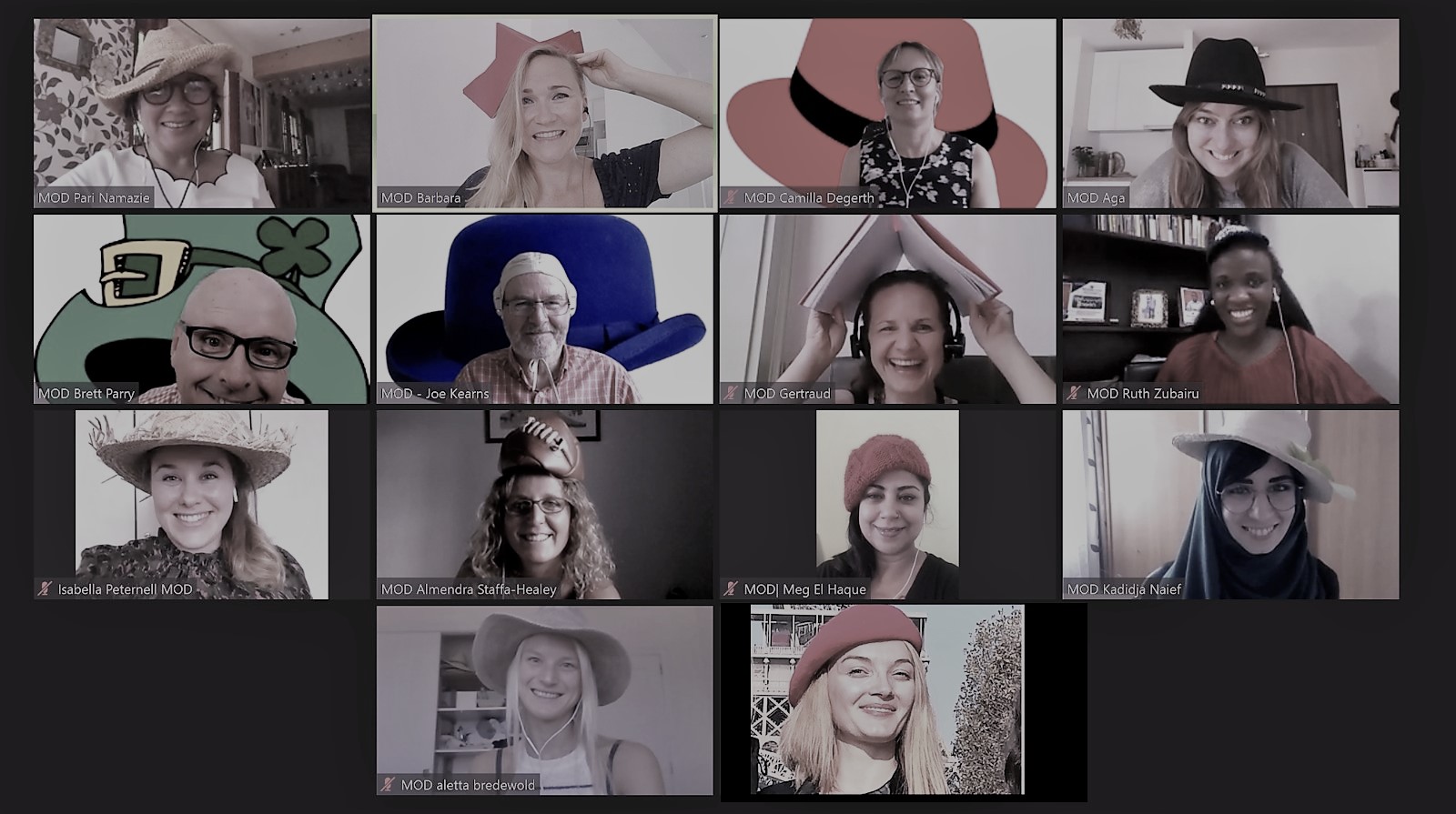There will be people who tend to solve problems with a rational mindset but may struggle when considering other perspectives like emotions, intuition, or creativity. As a result, they sometimes ignore the factors that can lead to change, or achieve significant breakthroughs. On the contrary, some people may be overly emotional and easily take risks to make decisions without preparing contingency plans, which puts them in danger.
The Six Thinking Hats technique was developed to help you solve these issues. It will help you evaluate the problem with multiple essential perspectives before making a decision. Let's learn about these magic hats and how to use them effectively!
| Who introduced the Six Thinking Hats? | Dr. Edward de Bono |
| When was'Six Thinking Hats' invented? | 1985 |
| Is Six Thinking Hats a brainstorming technique? | Yes |
Table of Contents
- Better Brainstorm Sessions with AhaSlides
- What Are Six Thinking Hats?
- How To Run A Six Thinking Hats Exercise In A Group?
- Examples Of Using Six Thinking Hats In Different Cases
- The Six Thinking Hats Template
- Key Takeaways
- Frequently Asked Questions

Need new ways to brainstorm?
Use fun quiz on AhaSlides to generate more ideas at work, in class or during gatherings with friends!
🚀 Sign Up For Free☁️
What Are Six Thinking Hats?
The "Six Thinking Hats" method was created by Dr Edward de Bono in 1980 and introduced in his book "6 Thinking Hats" in 1985. It is a highly effective method for improving your parallel thinking process, and decision-making abilities by evaluating problems from multiple perspectives.
With Six Thinking Hats, you can have a large picture of the situation and identify potential risks and opportunities that might go unnoticed.
In addition, this method can be applied either individually or within a group discussion, which can help to prevent conflicts that may arise when multiple team members have differing opinions about a particular issue.
- Creative Writing Examples
- Idea Board | Free Online Brainstorming Tool
- Creative Problem Solving Examples

Let's "put on" Six Thinking Hats in turn to evaluate the problem. When you put on a hat, you switch to a new way of thinking.
#1. White Hat (the Object hat)
When you wear the White Hat, you will only focus on objective thinking, based on facts, data, and information.
In addition, this hat emphasizes the importance of gathering accurate and relevant information to make informed decisions. So you can avoid making decisions based on assumptions or personal biases. And all decisions are grounded in reality and backed up by data, increasing successful outcomes.
Questions that may help you when wearing this hat are:
- How much information do I have on this situation?
- What information do I require regarding the situation at hand?
- What information and data am I missing?
#2. Red Hat (the Emotion hat)
The red hat represents emotions, feelings, and intuition.
When you wear the Red Hat, you are free to express your emotional reactions to a current problem without needing to justify or explain them. This can be especially helpful when an issue may be particularly complex or emotionally charged and require a more subtle approach.
Some questions you can use when wearing this:
- What am I feeling right now?
- What does my intuition tell me about this?
- Do I like or dislike this situation?
By acknowledging and exploring these emotional reactions, you can better understand the impact your decisions may have and take steps to address them. It can help you make more balanced and empathetic decisions overall.
#3. Black Hat (the Cautious hat)
The Black Hat will help you predict negative outcomes by thinking critically and identifying potential risks, weaknesses, and problems.
With the Black Hat, you can evaluate a situation from a negative perspective, you have to understand the risks and pitfalls surrounding it. It can be especially helpful when a decision could have serious consequences.
Therefore, by wearing this hat, you can identify areas for improvement and develop contingency plans to address potential problems.
Here are some questions that may help when using the hat:
- What problems can happen?
- What difficulties might arise in doing this?
- What are the potential risks?
#4. Yellow Hat (the Positive hat)
The Yellow Hat in the Six Thinking Hats represents optimism and positivity. It helps you evaluate the situation with the potential benefits and opportunities, and approach it with a positive perspective.
Like the Black Hat, this one is essential when your decision can have significant positive consequences or effects.
By wearing the yellow, you can identify areas for growth and development and find ways to capitalize on the positive elements of the situation. This ensures that decisions are not only well-informed but also lead to success and positive outcomes.
#5. Green Hat (the Creative hat)
The Green Hat expresses creativity and encourages you to generate new ideas, innovations, and possibilities. It requires you to approach problems with an open mind and actively seek new and creative solutions.
When traditional solutions are no longer effective, all you need to do is put on the hat, and ask these questions:
- Are there any other options?
- What else can I do in this situation?
- What are the advantages of implementing this new method of doing things?
- What is the positive aspect of this situation?
By looking at new and creative possibilities through the Green Hat, you can break out of traditional thinking patterns and generate new ideas.
#6. Blue Hat (the Process hat)
The Blue Hat in Six Thinking Hat represents the big picture and it is responsible for managing the thinking process. It helps you keep the conversation focused and organized, ensuring the thought process remains efficient and productive.
Wearing the Blue Hat, you can assess a problem from a strategic perspective to manage the thinking processes. It is useful when many viewpoints or ideas are needing to be presented, and you have to organize and prioritize them effectively.
Therefore, with this hat, you can ensure that the conversation remains productive and all opinions are taken into account. This can help avoid misunderstandings or missed opportunities.
How To Run A Six Thinking Hats Exercise In A Group?

The Six Thinking Hats method is designed to encourage diverse perspectives and collaboration. All participants are encouraged to be open to different perspectives and ideas. Here are the steps to do the Six Thinking Hats exercise in a group:
- Define the problem. Clearly define the situation or problem the team will focus on. Make sure everyone understands and agrees on the problem statement.
- Assign hat. Assign each participant a specific thinking hat. Encourage them to fully capture their assigned point of view within their allotted time.
- Set a time limit for each thinking hat. Keep the conversation focused and ensure that each point of view is fully explored. Usually, each hat is limited to 5-10 minutes.
- Rotate Hat. After the time limit for each hat is up, participants rotate to the next hat in a clockwise or counterclockwise direction. Everyone has an opportunity to explore each perspective.
- Summarize. After using all the hats, summarize the findings and ideas that arise during the implementation. Identify common themes and potential solutions.
- Decide on a course of action: Based on the solutions and ideas generated during the meeting, the team decides on action items or the next steps to continue the problem-solving process.
Examples Of Using Six Thinking Hats In Different Cases
Check out a few six thinking hats scenarios below!
#1. Product Development
A team could use the Six Thinking Hats to generate ideas for a new product.
- The white hat: focuses on market research and data
- The red hat: focuses on customer preferences and emotions
- The black hat: identifies potential risks or limitations
- The yellow hat: identifies potential benefits or advantages
- The green hat: finds new and creative ideas
- The blue hat: organizes and prioritizes the ideas generated.
#2. Conflict Resolution
The Six Thinking Hats could resolve a conflict between two team members.
- The white hat: focuses on information, background causes conflict situations
- The red hat: focuses on each person's emotions and feelings
- The black hat: immediate potential obstacles or challenges if two people are still in conflict, unable to communicate (for example, affecting the work progress of the whole team)
- The yellow hat: identifies potential solutions or compromises (e.g. both will go out and take a breather and reflect on the problem)
- The green hat: finds a new solution to solve the problem (e.g. give two people a bonding session to understand each other better)
- The blue hat: manages the discussion and keeps it focused.
#3. Strategic Planning
Six Thinking Hats could help your team develop a strategic plan for a new marketing campaign.
- The white hat: focuses on the current market trends and data
- The red hat: focuses on expressing their feelings about the campaign
- The black hat: discusses potential risks and challenges such as a low ROI
- The yellow hat: identifies potential benefits such as increased brand awareness
- The green hat: brainstorms creative ideas for the campaign
- The blue hat: manages how to organize and implement the best ideas

The Six Thinking Hats Template
This Six Thinking Hats Template helps you and your team to prevent bias and ensures that all perspectives are thoroughly considered before making a decision:
- White Hat: What are the facts and information we have?
- Red Hat: How do we feel about the situation? What is our intuition telling us?
- Black Hat: What are the potential risks and challenges associated with the situation?
- Yellow Hat: What are the potential benefits and opportunities associated with the situation?
- Green Hat: What are some creative solutions or ideas to solve it?
- Blue Hat: How can we manage the thinking process and ensure we stay focused on finding a solution?
Key Takeaways
Six Thinking Hats are the ideal ways to assess the impact of a decision from multiple perspectives. It helps you combine emotional factors with rational decisions and encourages creativity. As a result, your plan will be more reasonable and tight. In addition, it can help you avoid conflicts, and communication mistakes and foresee the downsides of an action plan.
And don't forget that AhaSlides can help you to make the most of this method. You can easily assign and switch between different thinking hats, track time limits for each phase of the discussion, and summarize findings at the end of the meeting with our interactive features like live polls, quizzes, word cloud, and live Q&A that can help to engage participants and make meetings more productive.
Frequently Asked Questions
How to teach 6 thinking hats theory?
Divide people into groups wearing different hats; then start to analyze an idea, case, or situation, and then ask each team to present their idea, based on their hat color. Then discuss as a whole, compare and contrast the different groups' ideas.
What are the criticisms of Six Thinking Hats?
The 6 Thinking Hats technique may not always be the best tool to use for meetings, discussions, and problem-solving activities. This is especially true when dealing with complex business scenarios involving many unknown and unpredictable factors, as using the 6 hats exercise may produce different outcomes. Despite its effectiveness in certain situations, it is crucial to understand when it is appropriate to use this technique and when to consider other problem-solving approaches.








